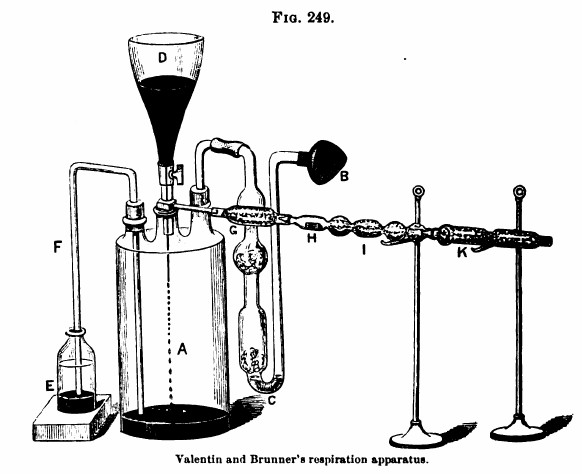From Treatise on human physiology by Henry Cadwalader Chapman, Published by Lea Brothers & Co, 1887, page 438.
“Let us endeavor to determine the amount of oxygen absorbed, and that of carbonic acid, etc., exhaled in a given time. This can be done is several ways the simplest of which consists in comparing the composition of the ordinary atmospheric air with that which has been breathed, with the object of determining the amount of oxygen absorbed during one inspiration, and multiplying this by the minutes, hours, etc. in order to obtain, approximately at least, the amount of oxygen absorbed in the twenty-four hours. The apparatus of Valentin and Brunner, as used by the author for this object, consists (Fig. 249) of a Woulff’s bottle A having a capacity of about a liter (61 cubic in.). One of the openings communicates with the mouth-piece B, into which the person expires, the air first passing through pumice-stone and sulphuric acid C so as to dry it. The middle opening communicates with the set of tubes G H I K. H and I contain phosphorus and baryta for the absorption of the oxygen and carbonic acid of the expired air, G and K pumice stone, etc., that of G for the absorption of watery vapors that may have escaped, the pumice-stone, etc., in C K for retaining that taken up by the dry air passing through the baryta solution, and which, if lost, would cause an error in the estimate of the carbonic acid exhaled, the tubes being weighed before and after the experiment. Through the middle opening of the Woulff’s bottle a funnel (D) provided with a stopcock is introduced, the opening then being hermetically closed. The funnel is filled with a know quantity of mercury. The manner of using the apparatus is as follows: having breathed for say fifteen minutes through the mouthpiece until the air of the Woulff’s bottle has been entirely displaced by the expired air, the mouth-piece is entirely closed, any external air being further prevented from passing into the Woulff’s bottle by the mercury in E acting as a valve, the air-tightness of the apparatus being assured by the rise of the mercury in the tube F, through the contraction of expired air in A, consequent upon its cooling and the closure of the tube funnel. The stopcock of the funnel being then turned, the mercury passes into the Woulff’s bottle, displacing a know quantity of expired, the latter passing into the set of tubes G H I K, previously adjusted to the middle opening. The weight of the tubes H and I having been previously determined, their increase in weight will give, respectively, the amount of cabonic acid and oxygen absorbed.”
